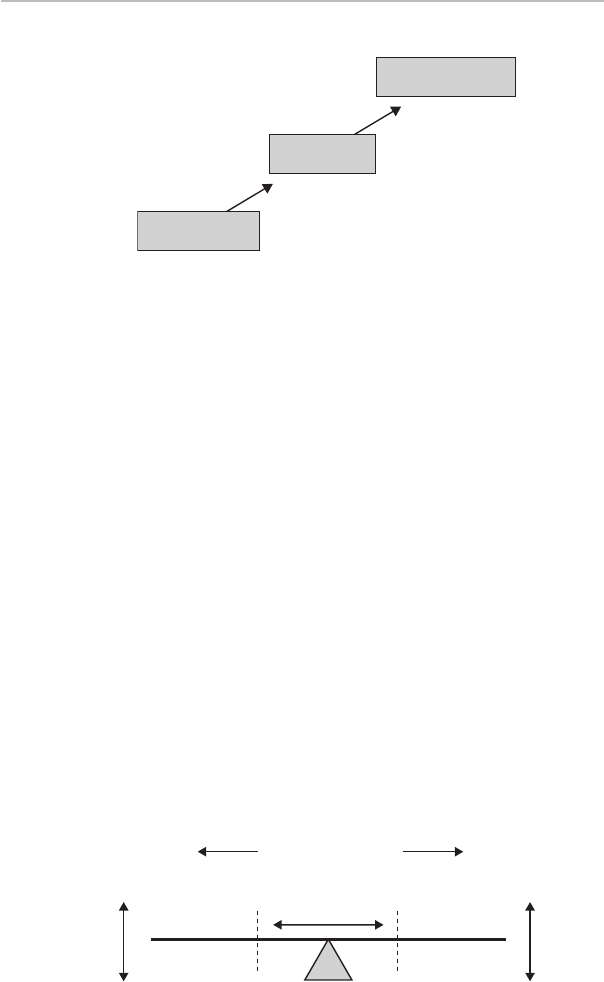
CHAPTER 5
Truly assertive
communication

To be assertive is to influence
It’s time to start thinking about putting your Confidence Project
into action. Part three of Brilliant Confidence bridges the gap
between thinking about being more confident and actually
putting it into practice.
You’ll see that the concept of assertiveness is a major compo-
nent here. Some people find it hard to differentiate between
assertiveness and confidence so let’s clarify this straight away.
We established at the beginning of Brilliant Confidence that con-
fidence is a skill that relates to your attitude and your state of
mind. Assertiveness is a skill too, but it relates to your behaviour
rather than to your mindset. So, in
short, confidence is a mental state
and assertiveness is a behaviour. The
important thing to acknowledge is
that both are skills you can learn.
There’s one major thing to remember here – self-belief and con-
fidence cannot exist if you don’t have the skills to be assertive.
It’s that important.
Confident people use assertive behaviour to influence others.
Influence is having the power to affect someone’s beliefs, actions
or thought processes.
The chain is simple (see Figure 5.1).
confidence is a mental
state and assertiveness
is a behaviour

106 brilliant confidence
Finding a balance
Truly assertive people have found that critical balance between
stating their case and taking account of the views of the other
person. They’ve acknowledged that their own needs, wants and
rights are equally as important as the other person’s. Truly con-
fident people have the ability to be truly assertive. They aren’t
just able to present their own case, they also have the sensitivity
and moral courage to accommodate the other person’s case if
necessary. They might even give in if they think the other person
is right or has a better idea.
True assertiveness falls in the middle of two extremes. It keeps
the seesaw balanced (See figure 5.2).
People who use their self-confidence effectively are able to
fine-tune the balance of the seesaw. They understand that
both passive and assertive behaviour are required for true
Achieve influence
Be assertive
Feel confident
Figure 5.1 The influence chain
Aggressiveness Assertiveness Passiveness
Area of control
Figure 5.2 The assertiveness seesaw

Truly assertive communication 107
assertiveness. However, they also know that extreme behaviour
in one or the other direction can unbalance the seesaw to such
an extent that control is lost. Confidence levels can be severely
dented if this happens.
Let’s have a look at what extreme behaviour in either direction
constitutes.
Aggressiveness
Aggressive people boldly insist that their rights, views and needs
prevail.
They fall into two categories:
Those who have an inflated ego and an unrealistic sense of
self-importance.
Those who use ‘aggressiveness’ as a way of hiding a deeper
sense of insecurity or another weakness.
Whichever category they fall into, aggressive people express their
feelings and opinions in a way that violates the rights of others.
They have no consideration for other’s opinions and, in extreme
cases, will be verbally and/or physically abusive in order to get
their way.
Aggressive people may get away with it in the short term but
eventually their behaviour will have a negative impact on their
self-confidence and self-belief.
brilliant
example
Pauline
Pauline was a newly qualified teacher in a secondary school. She had just
finished her first year there. She was told by her department head during
her annual appraisal that she was perceived by both colleagues and
students as ‘aggressive’. She’d known for a while that something wasn’t
Get Brilliant Confidence now with the O’Reilly learning platform.
O’Reilly members experience books, live events, courses curated by job role, and more from O’Reilly and nearly 200 top publishers.

